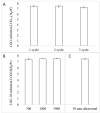Visible-Light Active Flexible and Durable Photocatalytic Antibacterial Ethylene-co-vinyl Acetate-Ag/AgCl/α-Fe2O3 Composite Coating
- PMID: 35745325
- PMCID: PMC9227942
- DOI: 10.3390/nano12121984
Visible-Light Active Flexible and Durable Photocatalytic Antibacterial Ethylene-co-vinyl Acetate-Ag/AgCl/α-Fe2O3 Composite Coating
Abstract
When particles are mixed in polymer, particle surfaces become passivated by polymer matrix, leading to significantly reduced photocatalytic and, thus, also reduced antibacterial activity, as the catalytic particles become isolated from the outer environment and microorganisms reaching the surface. Herein, we demonstrate a facile and rapid approach for coating preparation at room temperature, yielding good adhesion of particles in combination with the particles' interface location. Flexible ethylene-co-vinyl acetate Ag/AgCl/α-Fe2O3 composite coatings were prepared by the spin-coating method. The synthesized photocatalytically active coating surface exhibited a distinct and rapid inhibition of bacterial growth, with at least a 7-log reduction of gram-positive bacteria Staphylococcus aureus viability after 30 min of visible-light illumination. We also analyzed the shedding of the Ag-ions and reactive oxygen species production from the composite coating and showed that reactive oxygen species played the main role in the photocatalytic bacterial inactivation, destroying the bacteria cell as proven by the Confocal Laser Scanning Microscopy.
Keywords: antibacterial; coating; hematite; nanoparticles; photocatalysis; silver; silver chloride.
Conflict of interest statement
The authors declare no conflict of interest.
Figures








References
-
- Rosenberg M., Visnapuu M., Saal K., Danilian D., Pärna R., Ivask A., Kisand V. Preparation and Characterization of Photocatalytically Active Antibacterial Surfaces Covered with Acrylic Matrix Embedded Nano-ZnO and Nano-ZnO/Ag. Nanomaterials. 2021;11:3384. doi: 10.3390/nano11123384. - DOI - PMC - PubMed
-
- Joost U., Juganson K., Visnapuu M., Mortimer M., Kahru A., Nõmmiste E., Joost U., Kisand V., Ivask A. Photocatalytic Antibacterial Activity of Nano-TiO2 (Anatase)-Based Thin Films: Effects on Escherichia Coli Cells and Fatty Acids. J. Photochem. Photobiol. B Biol. 2015;142:178–185. doi: 10.1016/j.jphotobiol.2014.12.010. - DOI - PubMed
-
- Ramsden J.J. Photocatalytic antimicrobial coatings. Nanotechnol. Percept. 2015;11:146–168. doi: 10.4024/N12RA15A.ntp.15.03. - DOI
Grants and funding
LinkOut - more resources
Full Text Sources

